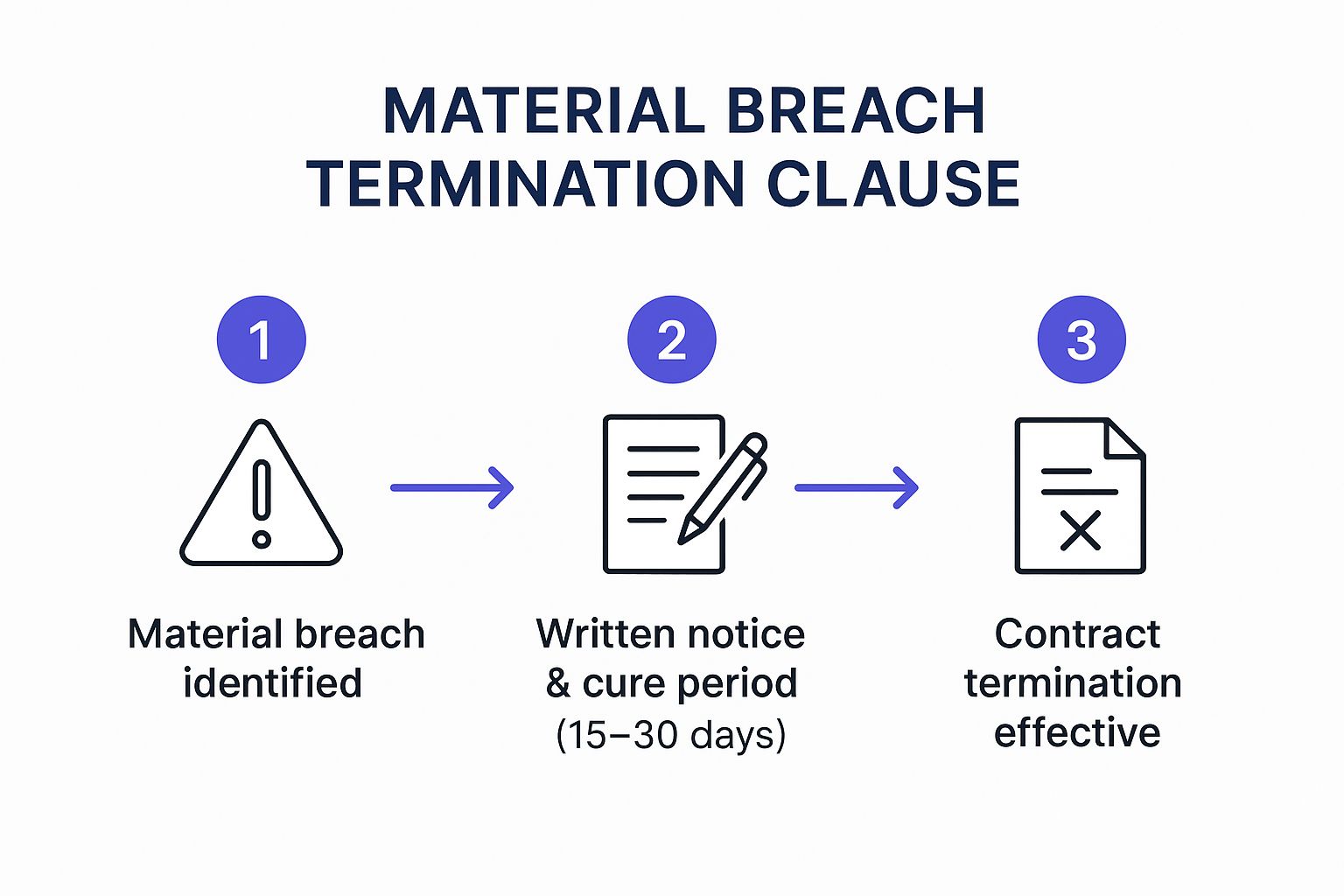
Every business relationship has a lifecycle, and a well-drafted contract anticipates its end. The termination clause is your strategic exit plan, a critical component that defines how and when a contractual agreement can be concluded. Neglecting this section can lead to costly disputes, prolonged obligations, and significant financial risk. This guide moves beyond theory to provide a deep dive into practical contract termination clause examples.
We will deconstruct six essential clause types, covering a wide range of business scenarios from mutual convenience to sudden insolvency. For each example, you will get:
- A breakdown of the legal language.
- Strategic analysis of its implications.
- Actionable tips for customization.
Whether you're a startup founder, a freelance professional, or part of an in-house legal team, mastering these examples will empower you to negotiate better agreements and navigate partnerships with confidence. This article provides the clear, actionable insights needed to draft clauses that protect your interests and ensure you always have a secure exit strategy. By understanding these provisions, you gain control over your contractual relationships from start to finish.
1. The 'No-Fault Divorce': Termination for Convenience Clause
The "termination for convenience" clause is one of the most powerful and flexible contract termination clause examples you can include. It acts as a strategic escape hatch, allowing one or both parties to end the agreement without having to prove fault, breach, or non-performance by the other party. This "no-fault" exit is invaluable in dynamic business environments where priorities shift, projects lose funding, or strategic alignments change unexpectedly.

While it provides freedom, this clause must be carefully constructed to ensure fairness. The core components typically include a requirement for advance written notice and an obligation to compensate the other party for all work completed and costs incurred up to the termination date. It strikes a delicate balance between unilateral flexibility and financial responsibility.
Clause Breakdown and Analysis
Let's examine a common structure for this clause:
"Party A may terminate this Agreement for any reason or no reason (for convenience) by providing Party B with thirty (30) days' written notice. Upon termination, Party A shall pay Party B for all services rendered and non-cancellable expenses incurred up to the effective date of termination. Party B shall not be entitled to any compensation for lost profits or other consequential damages."
This example establishes three critical elements:
- The Right: Clearly grants the power to terminate without cause.
- The Process: Specifies the notice period (30 days) and method (written).
- The Consequence: Defines the financial settlement, covering work performed while explicitly excluding claims for future profits.
Strategic Application and Best Practices
This clause is particularly useful for clients or buyers in long-term projects or service agreements where uncertainty is high. For service providers, it can be a point of negotiation; agreeing to it might require a higher project fee or a specific "kill fee" to compensate for the risk.
Here are actionable tips for implementation:
- Define Notice Precisely: Don't just say "written notice." Specify the method, such as "certified mail to the address listed in Section X" or "email to the designated project manager," to avoid disputes over whether notice was properly received.
- Establish a "Kill Fee": For providers, negotiating a fixed termination payment (a kill fee) can create cost certainty. This fee compensates you for reallocating resources and the opportunity cost of turning down other work.
- Clarify Payment Procedures: Detail the final invoicing process. State that the terminated party must submit a final invoice within a specific timeframe (e.g., 15 days) and the terminating party must pay it within another timeframe (e.g., 30 days) to ensure a clean financial break.
- Specify Non-Recoverable Costs: Explicitly list what is not covered, such as "lost future profits, overhead not directly allocable to the project, or speculative damages." This prevents ambiguity and future litigation.
2. The 'Consequence for Cause': Material Breach Termination Clause
The material breach clause is a cornerstone of contract enforcement and one of the most critical contract termination clause examples. It allows a party to terminate the agreement when the other party fails to fulfill a significant obligation, a violation so severe that it undermines the fundamental purpose of the contract. Unlike termination for convenience, this clause requires a specific cause, or "breach," providing a powerful remedy against non-performance.
This clause almost always includes a "cure period," a specified timeframe during which the breaching party has an opportunity to fix the problem. This mechanism prevents immediate termination for minor or accidental issues, promoting fairness and giving the relationship a chance to be salvaged before resorting to the drastic step of termination.
The following infographic illustrates the typical process flow kicked off by a material breach.

This flow highlights the structured, step-by-step nature of exercising this clause, moving from identification to a formal cure period before termination becomes final.
Clause Breakdown and Analysis
Let's dissect a standard material breach termination clause:
"Either party may terminate this Agreement in the event of a material breach by the other party. The terminating party shall provide written notice to the breaching party, detailing the nature of the breach. The breaching party shall have fifteen (15) days from the date of receipt of the notice to cure the breach. If the breach is not cured within this period, the termination shall become effective immediately upon the expiration of the cure period."
This example clearly outlines three essential components:
- The Trigger: Termination is conditional on a "material breach."
- The Process: It mandates written notice that specifies the failure.
- The Second Chance: It provides a defined cure period (15 days) for the breaching party to remedy their mistake before the contract is officially voided.
Strategic Application and Best Practices
This clause is essential in any contract where performance is critical, such as supply agreements, software licenses, and service contracts. It protects you from being locked into an agreement with a party that is not holding up its end of the bargain.
Here are actionable tips for implementation:
- Define 'Material Breach': Avoid ambiguity by defining what constitutes a material breach. For example, list specific failures like "failure to make payment for more than 30 days," "unauthorized use of intellectual property," or "failure to deliver goods conforming to the specifications in Exhibit A."
- Specify Cure Period Duration: Clearly state the length of the cure period. Consider tailoring it to the type of breach; a payment failure might have a 10-day cure period, while a complex service failure might require 30 days.
- Detail the Notice Requirements: Be explicit about how notice must be delivered. Specify the method (e.g., "via certified mail and email to the contacts listed in Section Y") and what information the notice must contain to be valid. This is crucial for avoiding later disputes over procedure. Learn more about how these details can help prevent issues in contract dispute resolution.
- Address Incurable Breaches: Include language for breaches that cannot be cured, such as a violation of confidentiality or illegal activity. For these, termination can be immediate upon notice, without a cure period.
3. The 'Finish Line': Automatic Expiration Clause
The automatic expiration clause provides a clear, definitive end to a contract. Unlike other contract termination clause examples that require a specific action or event, this clause sets a predetermined date or milestone, after which the agreement simply ceases to exist. It’s the contractual equivalent of a finish line, providing absolute certainty about the agreement’s lifespan without needing any formal termination procedures.

This approach is ideal for agreements tied to a specific duration, such as a one-year software license, a seasonal service contract, or a project with a fixed timeline. By building the end date directly into the agreement, both parties can plan their resources and next steps with confidence, eliminating the ambiguity and administrative burden of a manual termination process.
Clause Breakdown and Analysis
Let's look at a straightforward example of an automatic expiration clause:
"This Agreement shall commence on the Effective Date and shall automatically terminate, without any action required by either party, on the two-year anniversary of the Effective Date (the 'Term'). Upon expiration, all rights and obligations of the parties under this Agreement shall cease, except for those provisions expressly stated to survive termination."
This example establishes three essential points:
- The Start: Clearly defines the commencement of the agreement.
- The End: Sets a non-negotiable, specific end date (two years from the start).
- The Aftermath: Specifies that obligations end, but carves out an exception for survival clauses (like confidentiality).
Strategic Application and Best Practices
This clause is perfect for fixed-term employment, project-based consulting, or any arrangement where the scope and duration are known upfront. It prevents contracts from lingering indefinitely and forces a re-evaluation if the relationship is to continue.
Here are actionable tips for implementation:
- Define Extension Procedures: Don't get caught scrambling. Include a section that details how the agreement can be renewed or extended, such as "any extension must be agreed upon in writing by both parties no later than 30 days prior to the end of the Term."
- Address Post-Termination Obligations: Be explicit about what happens after the contract ends. Specify the timeline for final payments, the return of confidential information or company property, and the transfer of any intellectual property.
- Consider Auto-Renewal with Opt-Out: For subscription-based services, an automatic renewal clause can be beneficial. Frame it carefully, such as: "This Agreement shall automatically renew for successive one-year terms unless either party provides written notice of non-renewal at least sixty (60) days prior to the end of the current term."
- Specify Survival of Clauses: Crucial obligations like confidentiality, indemnification, and governing law should not expire with the contract. Explicitly state which sections "shall survive the termination or expiration of this Agreement."
4. Insolvency and Bankruptcy Termination Clause
This clause serves as a critical financial safeguard, allowing one party to immediately terminate an agreement if the other party shows clear signs of financial collapse. It is one of the most proactive contract termination clause examples for mitigating risk, as it prevents you from being tied to a partner who can no longer fulfill their obligations due to insolvency, bankruptcy proceedings, or similar events of financial distress. The goal is to cut ties before you incur losses from non-performance or get entangled in complex bankruptcy court proceedings.
This clause protects the solvent party from pouring more resources into a failing partnership. It is particularly vital in long-term agreements, like supply contracts or software licensing, where the counterparty's ongoing financial health is essential for the contract's success. It acts as an early warning system that triggers a contractual exit.
Clause Breakdown and Analysis
Let's dissect a typical insolvency and bankruptcy termination clause:
"Either Party may terminate this Agreement with immediate effect upon written notice to the other Party, in the event that the other Party: (a) becomes insolvent or is unable to pay its debts as they become due; (b) files a voluntary petition for bankruptcy; (c) has an involuntary petition for bankruptcy filed against it that is not dismissed within sixty (60) days; or (d) makes a general assignment for the benefit of its creditors."
This example clearly outlines the triggering events:
- The Right: Establishes the right to terminate immediately, bypassing standard notice periods.
- The Triggers: Lists specific financial distress events, including both formal bankruptcy filings and general insolvency (inability to pay debts).
- The Process: Requires written notice to formalize the termination, ensuring a clear record of when and why the contract was ended.
Strategic Application and Best Practices
This clause is essential for any business engaged in contracts with ongoing payment or performance obligations, such as manufacturing, distribution, or long-term service agreements. Its effectiveness depends on its precision and its alignment with applicable bankruptcy laws, which can sometimes limit the enforceability of such clauses (known as ipso facto clauses).
Here are actionable tips for implementation:
- Specify Broad Triggering Events: Go beyond just "bankruptcy." Include triggers like "appointment of a receiver," "making an assignment for the benefit of creditors," or "ceasing to conduct business in the normal course" to cover a wider range of financial failures.
- Include Rights to Adequate Assurance: Add a provision allowing you to demand "adequate assurance of future performance" if you have reasonable grounds for insecurity about the other party's financial stability. Their failure to provide such assurance within a set timeframe (e.g., 10 days) can then become a trigger for termination.
- Address Prepaid Amounts and Assets: The clause should specify what happens to any prepaid fees or property held by the insolvent party. For instance, state that upon termination, all prepaid, unearned fees must be returned immediately, and any of your materials or IP must be returned.
- Consult Legal Counsel on Enforceability: The enforceability of these clauses can be restricted under bankruptcy codes in some jurisdictions. This is a key area of small business risk management, and getting legal advice ensures your clause is drafted to be as robust as possible within legal limits. For more information, you can learn about managing such risks from various online resources.
5. Change of Control Termination Clause
A "change of control" clause is a vital protective measure in agreements where the identity, reputation, or expertise of the other party is fundamental to the deal. This is one of the most strategic contract termination clause examples because it allows a party to exit an agreement if the company they contracted with is acquired, merged, or otherwise undergoes a significant change in ownership or management. It prevents a party from being forced into a relationship with a new, unknown, or undesirable entity, such as a direct competitor.

This clause is essential in joint ventures, technology licensing, and professional services contracts. It ensures that the trust and strategic alignment that existed at the outset are not compromised by a corporate transaction. The clause safeguards against situations where a new owner might have conflicting interests, a poor financial standing, or lack the specific capabilities of the original partner.
Clause Breakdown and Analysis
Let's dissect a typical change of control clause:
"Either party may terminate this Agreement upon sixty (60) days' written notice to the other party in the event of a Change of Control of the other party. For purposes of this clause, a 'Change of Control' shall mean: (a) the sale or transfer of more than fifty percent (50%) of the voting stock or ownership interests of the party; (b) a merger, consolidation, or other business combination where the party is not the surviving entity; or (c) the sale of all or substantially all of the party's assets."
This example defines three core components:
- The Trigger: Clearly specifies what constitutes a "Change of Control," including thresholds for stock sales, mergers, and asset sales.
- The Right: Grants the non-changing party the explicit power to terminate the contract.
- The Process: Establishes a formal procedure, requiring a 60-day written notice period for termination.
Strategic Application and Best Practices
This clause is critical for any business entering a partnership based on the unique qualities of the other entity, like a startup with proprietary technology or a service firm with key talent. It protects your interests when the counterparty's core identity changes.
Here are actionable tips for implementation:
- Define Control Precisely: Don't be vague. Specify an exact ownership percentage (e.g., 50.1%) that triggers the clause. Consider including indirect changes, such as a change in control of a parent company.
- Require Advance Notice of Changes: Include a provision that obligates the other party to inform you of any potential or pending change of control events as soon as they are known. This gives you time to assess the situation and plan accordingly.
- Incorporate a "Right to Consent" Option: Instead of making termination automatic, consider adding language that gives you the option to consent to the change. This provides flexibility; you can approve the change if the new owner is acceptable or terminate if they are not.
- Carve Out Exceptions: To avoid unnecessary triggers, you can add exemptions for internal reorganizations, transfers to wholly-owned subsidiaries, or public offerings that do not fundamentally alter management or strategic direction.
6. Regulatory or Legal Change Termination Clause
In a world governed by ever-evolving laws and regulations, the "regulatory or legal change" termination clause is a critical shield against unforeseen legal risks. This is one of the most important contract termination clause examples for businesses in highly regulated industries. It allows one or both parties to terminate an agreement if a change in law makes continuing the contract illegal, impossible, or commercially impracticable. This foresight prevents parties from being trapped in a contract that has become legally untenable or financially ruinous due to external government action.

This clause is essential for any long-term agreement where compliance is key, such as in healthcare, finance, or international trade. It acknowledges that the legal landscape is not static and provides a structured exit path when compliance becomes a fundamental obstacle. The key is to define what constitutes a qualifying legal change and the process for invoking termination.
Clause Breakdown and Analysis
Let’s review a typical regulatory change termination clause:
"If any new law, regulation, government policy, or judicial interpretation thereof ("Legal Change") comes into effect after the execution of this Agreement that, in the terminating party's reasonable judgment, makes performance of its obligations hereunder illegal or commercially impracticable, that party may terminate this Agreement by providing sixty (60) days' written notice to the other party. The parties agree to first consult in good faith for a period of thirty (30) days to determine if the Agreement can be modified to comply with the Legal Change before notice of termination is served."
This example contains three crucial components:
- The Trigger: Defines what constitutes a "Legal Change" and sets a standard ("illegal or commercially impracticable") for its impact.
- The Process: Mandates a consultation period (30 days) to seek a solution before allowing termination with a subsequent notice period (60 days).
- The Standard: Uses "reasonable judgment," which provides some flexibility but prevents arbitrary termination.
Strategic Application and Best Practices
This clause is indispensable for any business operating across borders or in sectors like environmental services, fintech, and healthcare, where regulatory shifts are common. Failing to include it can expose you to significant compliance costs or legal penalties.
Here are actionable tips for implementation:
- Specify Qualifying Changes: Be explicit about what types of legal events trigger the clause. List items like "new statutes, regulations, governmental sanctions, tariffs, or final, non-appealable court orders." This avoids debates over what counts.
- Define "Commercially Impracticable": This term can be ambiguous. Consider setting a materiality threshold, such as "a change that increases the cost of performance for one party by more than 25%."
- Mandate a Consultation Period: Always include a requirement for the parties to negotiate in good faith to adapt the contract before termination. This can save a valuable business relationship. Keeping a detailed business compliance checklist can help identify potential modifications during this period.
- Clarify Geographic Scope: State which jurisdictions' laws apply. Specify "any applicable federal, state, or local law in the United States" or "any regulation imposed by the European Union" to prevent confusion, especially in international contracts.
6 Contract Termination Clauses Compared
| Termination Clause | Implementation Complexity 🔄 | Resource Requirements ⚡ | Expected Outcomes 📊 | Ideal Use Cases 💡 | Key Advantages ⭐ |
|---|---|---|---|---|---|
| Termination for Convenience Clause | Low to Moderate 🔄 | Moderate ⚡ | Flexible exit, possible costs 📊 | Government contracts, IT services, consulting | Maximum flexibility, reduces disputes ⭐ |
| Material Breach Termination Clause | Moderate to High 🔄 | High ⚡ | Exit for serious violations, legal remedies 📊 | Software licenses, supply, employment contracts | Protects against major breaches, cure period ⭐ |
| Automatic Expiration Clause | Low 🔄 | Low ⚡ | Contract ends automatically, certainty 📊 | Fixed-term employment, projects, seasonal services | Simplifies administration, no notice needed ⭐ |
| Insolvency and Bankruptcy Clause | Moderate 🔄 | Moderate ⚡ | Immediate termination on financial distress 📊 | Supply, licensing, leases | Protects from financial risk, quick exit ⭐ |
| Change of Control Termination Clause | Moderate to High 🔄 | Moderate ⚡ | Exit on ownership/management changes 📊 | Professional services, tech startups, joint ventures | Maintains control, preserves expectations ⭐ |
| Regulatory or Legal Change Termination Clause | Moderate 🔄 | Moderate ⚡ | Exit if laws/regulations change materially 📊 | Healthcare, financial services, international trade | Protects from legal risks, compliance ⭐ |
From Clause to Confidence: Mastering Your Contractual Exits
Navigating the landscape of contract termination clauses is a critical skill for any business owner, freelancer, or legal professional. As we've seen, these clauses are far more than just standard legal text; they are powerful strategic instruments that provide essential control, flexibility, and protection for your interests. They are your contractual safety net, designed to function under specific, and often stressful, circumstances.
The detailed contract termination clause examples explored throughout this article, from the unilateral power of a Termination for Convenience clause to the protective measures in an Insolvency clause, all underscore a central theme: precision is paramount. A vague or poorly defined clause can lead to costly disputes, damaged relationships, and significant operational disruption. A well-crafted one, however, provides a clear and predictable path forward, no matter what the future holds.
Core Takeaways for Strategic Contract Management
To transform your understanding into action, focus on these fundamental principles derived from our analysis:
- Proactive Planning Over Reactive Scrambling: Don't wait for a problem to arise to understand your exit options. The best time to negotiate a termination clause is before you sign the contract, when leverage is balanced. Think through potential "what-if" scenarios specific to your industry and relationship.
- Define Everything: Ambiguity is your enemy. Clearly define what constitutes a "material breach," specify the exact notice periods required, and outline the post-termination obligations for both parties, such as data return or final payments.
- Tailor to the Context: One size does not fit all. The inclusion of a Change of Control clause is vital for a tech startup eyeing an acquisition, while a Regulatory Change clause is non-negotiable for a business in a heavily regulated industry like finance or healthcare. Always customize your clauses to the specific agreement.
- Documentation is Your Defense: If you must trigger a termination, your ability to prove the cause is crucial. Maintain meticulous records of performance issues, communications, and any events that trigger a termination right. This documentation is your best defense against claims of wrongful termination.
Ultimately, mastering these clauses is about shifting your mindset. See them not as a pessimistic prediction of failure but as a pragmatic tool for managing risk and maintaining business agility. The confidence that comes from knowing you have a clear, fair, and enforceable exit strategy allows you to build stronger, more transparent business relationships from the outset. By applying the tactical insights from these contract termination clause examples, you can ensure every agreement you sign protects your future and empowers your strategic decisions.
Tired of manually decoding dense legal agreements? Bring clarity and confidence to your contract review process with the Legal Document Simplifier. Our AI-powered tool analyzes complex clauses, like the termination examples covered here, and translates them into simple, actionable summaries so you can spot risks and opportunities in minutes, not hours. Visit the Legal Document Simplifier to start your free trial today.